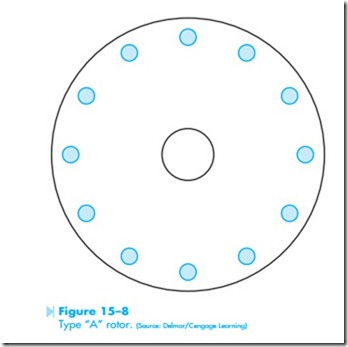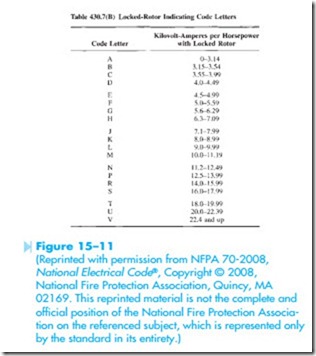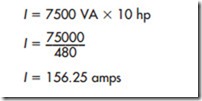CODE LETTERS
Squirrel-cage rotors are not all the same. Rotors are made with different types of bars. The type of rotor bars used in the construction of the rotor deter- mines the operating characteristics of the motor. AC motors are given a code letter on their name- plate. The code letter indicates the type of bars used in the rotor. Figure 15–8 shows a rotor with type “A” bars. A type “A” rotor has the highest resistance of any squirrel-cage rotor. This means that the starting torque is high since the rotor current is closer to being 90° out of phase with the stator current than the other types of rotors. The high resistance of the
rotor bars limits the amount of current flow in the rotor when starting. This produces a low starting current for the motor. A rotor with type “A” bars has very poor running characteristics, however. Because the bars are resistive, a large amount of voltage will have to be induced into the rotor to pro- duce an increase in rotor current and, therefore, an increase in the rotor magnetic field. This means that when load is added to the motor, the rotor must slow down a great amount to produce enough current in the rotor to increase the torque.
Figure 15–9 shows a rotor with bars similar to those found in rotors with code letters B through E. These rotor bars have lower resistance than the type “A” rotor. This rotor has fair starting torque, low starting current, and fair speed regulation.
Figure 15–10 shows a rotor with bars similar to those found in rotors with code letters F through V. This rotor has low starting torque, high starting current, and good running torque. This type of rotor also has good speed regulation.
The code letter found on the nameplate is also used to determine the amount of locked rotor current for the motor. Locked rotor current is the amount of current the motor will draw at the moment of starting. Figure 15–11 shows Table 430.7(B) of the National
Electrical Code.® This table is used to determine the locked rotor current for a squirrel-cage rotor. To use the table, the horsepower, code letter, and voltage of the motor must be known. For this example, assume
the motor is 10 horsepower, has a code letter J, and is operated on a 480-volt line. The table lists the locked rotor currents in kilovolt-amperes per horsepower. The table shows that code letter J is 7.1 to 7.99. For this calculation, a midvalue of 7.5 will be used. Because the values are listed in kilovolt-amperes, 7.5 is actually 7,500 volt-amperes. To find the locked rotor current, multiply the kVA rating by the horse- power, and then divide by the voltage.



